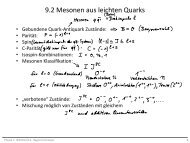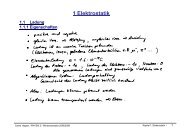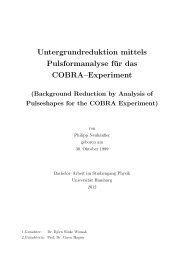Setup of a Drift Tube Muon Tracker and Calibration of Muon ...
Setup of a Drift Tube Muon Tracker and Calibration of Muon ...
Setup of a Drift Tube Muon Tracker and Calibration of Muon ...
Create successful ePaper yourself
Turn your PDF publications into a flip-book with our unique Google optimized e-Paper software.
e −ν eν xe −¡W ±ν ee−(a) CC elastic scattering¡Z 0ν xe−(b) NC elastic scatteringFigure 4.2: Elastic scattering <strong>of</strong> neutrinos in matter. The cross section is six timeshigher for ν e than for the other neutrino types due to the CC reaction.neutrinos is possible.Elastic scattering <strong>of</strong> neutrinos is also possible on protons. However, due to therelatively large proton mass, the transferred energy is much smaller than in theelectron’s case. Nevertheless, this reaction is <strong>of</strong> interest in the case <strong>of</strong> high energeticν x e.g. from super-nova explosions.4.1.2 Inverse β DecayThe main reaction channel for anti electron type neutrinos is the inverse β decay onprotons:¯ν e + p → e + + n. (4.2)The ¯ν e is captured by a proton under the emission <strong>of</strong> both a neutron <strong>and</strong> a positron.This process can be identified by the coincidence signal from the positron annihilation<strong>and</strong> the delayed neutron capture. It leaves a distinct signature which can beeasily identified: the positron carries away most <strong>of</strong> the reaction’s energy. It annihilatesalmost immediately thus producing a prompt signal from which the eventtime <strong>and</strong> the neutrino’s energy can be deduced. The second signal occurs whenthe free neutron is captured. This typically happens after 250ñs on a free proton<strong>and</strong> is accompanied by the release <strong>of</strong> a photon <strong>of</strong> 2.2 MeV which corresponds to thedeuteron’s binding energy. This coincidence signal <strong>of</strong> a distinct energy is a strongindicator <strong>of</strong> an inverse β decay.The energy threshold for the reaction can be derived easily using energy conservationby looking at the masses m x <strong>of</strong> the particles involved:E ν,min = (m n + m e ) 2 − m 2 p2m p= 1.806MeV.Anti electron neutrinos below this threshold cannot be detected. The energy E promptreleased in the prompt annihilation <strong>of</strong> the positron is directly connected to theincoming neutrino’s energy: E prompt = E¯νe − 0.782MeV.53





